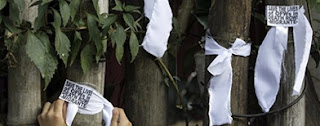No time for miracle.
How does it feel to know that a few more hours you will be killed?
Sally Ordinario, one of the three Filipino OFW executed in China yesterday, doesn't know her future until she saw her family in Xiamen detention. She was surprised to see her family as she asked them "Bakit kayo nandirito? Mamamatay na ba ako?" After the execution, the Chinese authority let them see the body of Sally and they saw the tears falling from the eyes of the late Sally Ordinario. "Mainit pa ang katawan niya at may luha sa kanyang mga mata," Jason Ordinario, brother of Sally, during his interview.
From abs-cbnnews.com, here is the full story.
3 Filipino drug couriers executed in China
MANILA, Philippines (3rd UPDATE) – The 3 Filipinos convicted of drug trafficking were executed on Wednesday morning in China, Vice-President Jejomar Binay told ANC.
Chinese authorities carried out the executions of Sally Ordinario-Villanueva, Ramon Credo and Elizabeth Batain via lethal injection.
Villanueva and Credo were both executed in the city of Xiamen while Batain’s sentence was meted out in Shenzhen.
Presidential Spokesperson Edwin Lacierda confirmed the news. He said the entire nation sympathizes with the families of the 3.
"The nation sympathized with the families of the condemned, sharing their sense of looming loss. We sympathize with these families now. Their deaths are a vivid lesson in the tragic toll the drug trade takes on entire families," he said.
The 3 were arrested separately in 2008 carrying packages of at least 4 kilograms of heroin.
Smuggling more than 50 grams of heroin or other drugs is punishable by death in China.
They were convicted and sentenced in 2009.
They were the first to be executed among the 72 Filipinos on death row in China due to drug-related cases, according to the Department of Foreign Affairs.
China, which has become a destination for drug traffickers due to its growing wealth, takes the drug trafficking problem "very seriously," Chito Sta. Romana, a journalist covering China, told ABS-CBN News. He said China is willing to bite the bullet and risk damage to Philippine ties as it considers the drug trafficking problem as more serious than its public image.
The executions were carried out just days after Amnesty International slammed Beijing's sweeping use of the death penalty.
'End chain of victimization'
'End chain of victimization'
In the statement, Lacierda said the Philippine government took every available opportunity to appeal to the authorities of China for clemency in the cases of the 3. "In the end, however, the sentence was imposed," he said.
He said Malacañang "is resolved to ensure that the chain of victimization, as pushers entrap and destroy lives in pursuit of their trade, will be broken."
"Those who traffic in illegal drugs respect no laws, no boundaries, and have no scruples about destroying lives. Our response must be relentless, with government and the citizenry working together to ensure vigilance and mutual support to prevent our countrymen from being used by drug pushers as sacrificial pawns, whether at home or abroad," he said.
President Benigno “Noynoy” Aquino III earlier ordered Vice President Binay and Justice Leila de Lima to probe as to why and how Filipino workers involved in drug trafficking can leave the country undetected by airport scanners.
With family
The 3 were with their families before the last hour.
Credo and Villanueva were with their kin Wednesday morning in Xiamen after the Fujian provincial government allowed the visit.
Villanueva's kin recounted to ABS-CBN that she was surprised to see them. In her final hours, she asked the Philippine government to ensure that her children have an education.
Batain's family visited her in Shenzen, and the promulgation of her sentence took place after the visit.
Villanueva's family saw her lifeless body at around 11:45 a.m., over an hour after the execution. Her kin said she had tears in her eyes.
Prayers
Family members and supporters of the 3 Filipinos stormed the heavens days before the execution day, hoping for a miracle even until the last hour.
On Saturday, Villanueva’s family made their last appeal to the
Filipino public to join them in their prayers. They flew to China the following day with a letter addressed to Chinese President Hu Jintao asking for clemency.
The Catholic Bishops' Conference of the Philippines (CBCP) also organized a prayer vigil on Tuesday.
Before Wednesday, the 3 Filipinos had not been informed that the Chinese Supreme Court upheld their death sentence last week. Death row convicts in China are told of their fate an hour before execution.
Appeals
Appeals
The Philippine government made several efforts seeking to spare Filipinos on death row in China.
In December, President Aquino did not send a representative to the Nobel Peace Prize ceremonyhonoring a jailed Chinese dissident.
It also deported to Beijing last month 14 Taiwanese facing fraud charges in China despite protests from Taipei.
The executions were originally set for February, but these were deferred following a last-minute attempt to stop them.
Vice President Jejomar Binay hand-carried a letter from President Aquino asking for clemency.
China cited humanitarian considerations in approving the deferment, which was a first given China's strict laws against drug traffickers.
This time, however, Malacañang and the Department of Foreign Affairs were resigned to the fate of the 3 Filipinos when the Chinese courts announced its decision to proceed with the executions this March.
The Philippine government said it respects the laws of China against drug trafficking, a heinous crime that has been rising rapidly in Asia through drug mules who hop from one country to the next.
Binay, however, was persistent. "Habang buhay pa, may pag-asa," he previously said. On Tuesday, he sent a second appeal letter, which he authored, to President Hu.






















































